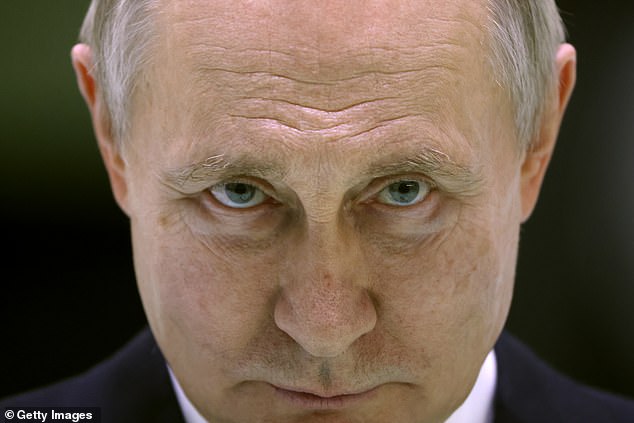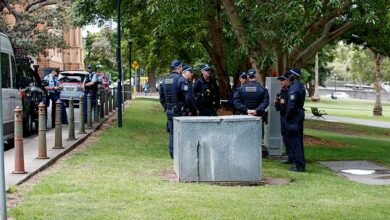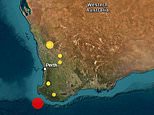ANDREW NEIL: It’s time to ignore Putin’s blood curdling threats, make clear we will not be cowed or intimidated – and give Ukraine what it needs

It was enough to send a shiver down the spine. If Britain and its NATO allies give Ukraine permission to fire long-range missiles supplied by the West at targets inside Russia, declared President Putin bluntly on Thursday night, then NATO and Russia would be ‘at war’.
Former Russian president Dmitry Medvedev, a Putin place-man, waded in warning that Britain would ‘sink’ under a tidal wave of hypersonic Russian missiles. Medvedev can be dismissed as a blustering toady. But Putin should always be taken seriously.
He commands the world’s biggest nuclear arsenal and his unprovoked invasion of Ukraine has shown him to be ruthless, brutal and unpredictable.
His threats are scary because Britain and America are in the process of approving the use of long-range missiles, including Britain’s Storm Shadow, by Ukraine to strike Russian territory. Prime Minister Sir Keir Starmer was in Washington yesterday meeting with President Biden to agree the go-ahead.
This does represent, to some extent, an escalation for NATO when it comes to supplying arms to Ukraine: firing them will require Western technical assistance and satellite guidance.
So will future historians look back on September 2024 as the month we teetered towards a major conflagration, taking careless steps that made it inevitable?
The world is certainly in a very dangerous place and mistakes by NATO or Russia could, indeed, spark a wider war far beyond Ukraine’s borders. But somehow I doubt we’re on the brink of World War Three.
For a start, the Cold War may be long over, but it’s still a MAD world: Mutual Assured Destruction. This doctrine dominated all stand-offs between the Soviet Union and NATO from the early 1950s till the fall of the Berlin Wall in 1989. It’s still in play today.
Yes, you have enough nuclear weapons to reduce us to rubble, but we have enough to do the same to you. So perhaps, it’s best neither of us bother. The simple, hard logic of MAD permeated the Kremlin as much as the White House throughout the Cold War and explains why there never was a nuclear exchange between what were then the world’s two superpowers.
It was always vulnerable, of course, to a madman taking power in Moscow, impervious to mass destruction, including of his own country. But, though there have been reports of Putin’s deteriorating mental state, Western intelligence believes MAD is still the dominant mood in the Kremlin today.
So if a nuclear war can be reasonably (if not with certainty) ruled out what would Putin’s threat of war look like? He can hardly have a clash of conventional forces in mind. His ailing military is in no state to challenge the sophisticated conventional might of NATO. It has struggled to beat the Ukrainians. It would be unlikely to make much headway against NATO’s well-armed, well-trained, high-tech battalions.

Putin rattles his sabre because he knows it frightens us – and we are always suitably frightened, writes Andrew Neil
The biggest fear in Western capitals is that a frustrated Putin resorts to tactical nuclear weapons on the Ukrainian battlefield.
Victory has eluded him since he launched what was meant to be a three-day ‘special military operation’ 31 long and bloody months ago. He could use Western missiles slamming into his territory as the excuse for unleashing some of his huge arsenal of tactical nukes on the Ukrainian military.
America has warned of ‘catastrophic consequences’ if he should do so, though it has not publicly explained exactly what they would be. Perhaps it has to the Kremlin through the usual back channels.
There would be no question of a Western nuclear response — that would unleash MAD — but I suspect America and its allies would mount a series of cyberattacks, with Britain’s excellent cyber offensive capabilities to the fore, designed to bring Russian city life to a halt. Which, in turn, could imperil the regime.
That’s why I believe Putin would think twice about using his tactical nukes on Ukraine. It would also infuriate his allies on whose support he’s depended to wage his godforsaken war, especially China. President Xi has warned him privately, but explicitly not to deploy nuclear weapons. Putin would become even more of a pariah on the world stage than he already is.
So for all his chilling threats, Putin’s options for a wider war are limited. Indeed, it’s not at all clear what shape it would take. I’m not sure even he knows.
I said earlier you should always take the Russian autocrat seriously. But perhaps the West has been taking him too seriously for too long, especially President Biden who has regularly faltered in the face of Putin’s threats.
Putin rattles his sabre because he knows it frightens us — and we are always suitably frightened. He likes to cow us, to make us hesitate in giving Ukraine our full backing, to delay sending the necessary sophisticated military in sufficient scale to help turn the war in Ukraine’s favour. To that extent Putin’s scare tactics have worked.
Every time Putin ups the ‘wider war’ rhetoric Biden has obsessed that any new weapons system for Ukraine would cross one of the Kremlin dictator’s supposed red lines — then acted too late and too little.
In the early months of the war, Biden was reluctant to send America’s lethal short-range artillery know as HIMARS. Then he dallied over sending M1 Abrams tanks. He took forever to dispatch F-16 fighter jets. And so on.
Every time, despite the Kremlin’s escalatory rhetoric, sending these weapons turned out not to be crossing a red line after all. It always turned out to be a Putin bluff — and became a series of bluffs for which we continually fell and which succeeded in slowing NATO help for Ukraine.
You’d think the White House would have worked out what was happening after the first couple of red lines were crossed that turned out not to be red lines. But Biden and his team of foreign-policy advisers are slow learners.
They have also dithered over sending long-range missiles. Moscow knows Britain has taken the initiative, which is probably the real reason Russia has just expelled six of our diplomats as ‘spies’. Missiles were at the top of Starmer’s agenda for his White House meeting with Biden yesterday. The French are also ready to send their equivalent missile, called Scalp.
With a range of 155 miles (versus only 48 miles for the HIMARS), the UK Storm Shadow would be able to hit Russian military air bases, ammunition dumps and other military installations.
The missiles will not change the course of the war — we don’t have enough to send to do that — but hitting bases inside Russia would make it more difficult for Putin to take back the 500 square miles of Russian territory in Kursk, which borders Ukraine, that Kyiv seized from Russia in a surprise raid. That could be an important bargaining card in any peace settlement.
The Russian air force has been using glide bombs, cheap but deadly, against Ukraine, launched from well inside Russian airspace. Missile attacks on air bases would disrupt their ability to bomb from a distance at will.

Putin has declared that if Britain and its allies give Ukraine permission to fire long-range missiles supplied by the West at targets inside Russia, then NATO and Russia would be ‘at war’
There has been growing impatience with American reticence in U.S. military and diplomatic circles.
Seventeen former U.S. ambassadors and generals wrote to the Biden administration this week saying it was time to change policy: ‘Easing the restrictions on Western weapons will not cause Moscow to escalate. We know this because Ukraine is already striking territory Russia considers its own — including Crimea and Kursk — with these weapons and Moscow’s response remains unchanged.’
The letter-writers were correct. Ukraine has already used U.S. HIMARS to destroy bridges in the Kursk region. British Challenger 2 tanks have also been spotted on Russian territory. Yet, for all his huffing and puffing, no sign so far of Putin starting World War Three.
Poland’s prime minister warned of giving his threats ‘excessive importance’. Putin has ‘lost credibility’, added Poland’s foreign minister. ‘We should allow the victim of aggression to use all necessary force to counter the action of aggression.’
Given its history and geography, if Poland isn’t frightened by Putin’s bluster, then we should not be scared either.
Even Biden’s own Secretary of State, Antony Blinken, started siding with the British over the missiles. Republican leaders in the Senate have also been calling for a more aggressive response when it comes to arms supplies, contrary to their presidential candidate Donald Trump whose route to ‘instant’ peace is effectively Ukraine’s surrender.
Resistance in Washington to sending long-range missiles was finally abandoned when it was revealed Iran was supplying Russia with more than 200 ballistic missiles to allow it to hit Ukrainian targets with greater precision, an ominous move which Washington rightly designated a ‘significant escalation’.
So, belatedly (again), Biden has bowed to pressure from allies and from inside his own government. Storm Shadows will be sent to Ukraine with U.S. approval but, curiously, not the U.S. equivalent, called ATACMS, with a range of almost 190 miles.
It’s the sort of self-defeating prevarication Putin’s bluffing has exploited brilliantly for 31 months. Ukraine could certainly do with the fillip longer-range missiles will provide. Russia has been making advances on a wide front in the east since early June. It is now barrelling relentlessly towards Pokrovsk, a crucial road and rail junction. The Russian military is close to controlling the entire Donetsk region.
If Ukraine hoped its incursion into Kursk would cause the Kremlin to divert forces to take it back, thereby taking pressure off its own military in the east, then it was mistaken.
Russia has mounted no counter attack to retake its lost land. We don’t know if Ukraine could hold on to its newly-occupied territory if there was one.
But that 500 square miles of Kursk that it holds could play a part in any possible peace settlement. And for all the bluster and bellicosity, talk of peace is in the air. The White House is keen to push it along. So are the Europeans.
Ukraine’s President Zelensky is heading to America to unveil what he’s describing as a ‘victory plan’, but is likely to contain concessions. Putin could also be in the peace business: calling his bluff over long-range missiles that can hit Russia might encourage him to realise he needs a path to peace, too.
Both sides would need to make huge compromises. Russia would have to accept that its mission to conquer Ukraine has failed. Ukraine would have to concede that Crimea remains Russian (though no doubt the UN could oversee a proper referendum to establish fairly and accurately the will of the people); and that a fair chunk of the Russian-speaking Donbas in the East is lost too (though it could be dressed up as some sort of autonomous region nominally separate from Russia and Ukraine).
Agreement on any of that would be hard enough. But the real argument would be over the land bridge between the Donbas and Crimea, currently occupied by Russia. It’s hard to see Ukraine agreeing to any peace deal that does not include the return of these lands, especially since it covers Mariupol whose brutal siege by Russian forces produced a heroic resistance before it fell, which has become to Ukrainian folklore and memory what the Alamo is to America.
When a powerful war lord threatens us with mass destruction people are right to be nervous. But fear is a bad guide to shaping our response. It makes us feel weaker than we are and forgetful of our strengths, which we too often underestimate. Putin uses fear to get us to do his bidding, just as he uses it to cajole and dominate his own people.
You have to be a pretty brave Russian to defy him. We don’t need to be that brave to refuse to be intimidated by him. We just need to stop cringing every time he issues one of his blood-curdling threats and take confidence in the strength of our deterrence and the allies who stand with us.
Shrinking before autocrats is never the path to peace. It is the road to submission. It is time to ignore his threats, to make it clear we will not be cowed or intimidated. Then to do the right thing — which is to put Ukraine in a strong enough position to sue for a just peace.
When Putin realises he no longer frightens us, then he too will have to give peace a chance.




